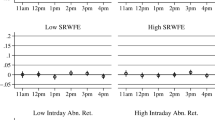Abstract
This study empirically investigates the information dynamics of the Ohlson valuation framework. Single-period lagged linear autoregressive relationships among dividends, earnings, and book values of equity are estimated for a sample of stochastically stationary firms and are found not to support the valuation framework. This study further extends the empirical analysis to a multilagged vector autoregressive linear information system. Consistent with the Ohlson valuation framework,the past time series of all three variables are generally found to be relevant for firm valuation. This study brings into question empirical research utilizing the Ohlson framework that presupposes a single-period lagged information dynamic.
Similar content being viewed by others
References
AkaikeH. (1969a). “Fitting Autoregressions for Prediction.”Annals of the Institute of Statistical Mathematics 21, 243–247.
AkaikeH. (1969b). “Statistical Predictor Identification.”Annals of the Institute of Statistical Mathematics 21, 203–217.
Bar-YosefSasson, Jeffrey L.Callen, and JoshuaLivnat. (1987). “Autoregressive Modelling of Earnings-Investment Causality.”Journal of Finance 42, 11–28.
DavidsonRussell and James G.MacKinnon. (1993).Estimation and Inference in Econometrics. Oxford: Oxford University Press.
DickeyDavid A., and Wayne A.Fuller. (1979). “Distribution of the Estimators for Autoregressive Time Series with a Unit Root.”Journal of the American Statistical Association 74, 427–431.
FamaEugene F., and HarveyBabiak. (1968). “Dividend Policy: An Empirical Analysis.”Journal of the American Statistical Association 63, 1132–1161.
Feltham, Gerald A., and James A. Ohlson. (1994a). “A No Arbitrage Valuation Model Based on Anticipated Realizations of Accounting Data.” Working paper, University of British Columbia.
Feltham, Gerald A., and James A. Ohlson. (1994b). “Uncertainty Resolution and the Theory of Depreciation Measurement.” Working paper, University of British Columbia.
FelthamGerald A., and James A.Ohlson. (1995). “Valuation and Clean Surplus Accounting for Operating and Financial Activities.”Contemporary Accounting Research 11, 689–731.
GarmanMark B. and James A.Ohlson. (1980). “Information and the Sequential Valuation of Assets in Arbitrage-Free Economies.”Journal of Accounting Research 18, 420–440.
GrangerClive W.J. (1969). “Investigating Causal Relations by Econometric Models and Cross-spectral Methods.”Econometrica 37, 424–438.
HanochGiora, and HaimLevy. (1969). “The Efficiency Analysis of Choices Involving Risk.”Review of Economic Studies 36, 335–346.
HealyPaul, and FrancoModigliani. (1990). “Dividend Decisions and Earnings.”Journal of Accounting, Auditing and Finance 5, 3–26.
HsiaoCheng. (1979a). “Autoregressive Modelling of Canadian Money and Income Data.”Journal of the American Statistical Association 74, 553–560.
HsiaoCheng (1979b). “Causality Tests in Econometrics.”Journal of Economic Dynamics and Control 1, 321–346.
HsiaoCheng. (1981). “Autoregressive Modelling and Money-Income Causality Detection.”Journal of Monetary Economics 7, 85–106.
MasaniPaul. (1996). “Recent Trends in Multivariate Prediction Theory.” In P. R.Krishnaiah (ed.),Multivariate Analysis I (pp. 351–382). New York: Academic Press.
MillerMerton H., and FrancoModigliani. (1961). “Dividend Policy, Growth and the Valuation of Shares.”Journal of Business 34, 411–433.
OhlsonJames A. (1979). “Risk, Return, Security Valuation and the Stochastic Behavior of Accounting Numbers.”Journal of Financial and Quantitative Analysis 14, 317–336.
OhlsonJames A. (1983). “Price-Earnings Ratios and Earnings Capitalizations Under Uncertainty.”Journal of Accounting Research 21, 141–154.
Ohlson, James A. (1989). “Accounting Earnings, Book Value, and Dividends: The Theory of the Clean Surplus Equation (Part I).” Working paper, Columbia University.
OhlsonJames A. (1990). “A Synthesis of Security Valuation Theory and the Role of Dividends, Cash Flows, and Earnings.”Contemporary Accounting Research 6, 648–676.
OhlsonJames A. (1995). “Earnings, Book Values, and Dividends in Security Valuation.”Contemporary Accounting Research 11, 661–687.
RyanStephen G. (1995). “A Model of Accrual Measurement with Implications for the Evolution of the Bookto-Market Ratio.”Journal of Accounting Research 33, 95–112.
ZellnerArnold. (1963). “Estimates for Seemingly Unrelated Regression Equations: Some Exact Finite Sample Results.”Journal of the American Statistical Association 58, 977–992.
Author information
Authors and Affiliations
Rights and permissions
About this article
Cite this article
Bar-Yosef, S., Callen, J.L. & Livnat, J. Modeling dividends, earnings, and book value equity: An empirical investigation of the ohlson valuation dynamics. Rev Acc Stud 1, 207–224 (1996). https://doi.org/10.1007/BF00555372
Issue Date:
DOI: https://doi.org/10.1007/BF00555372




